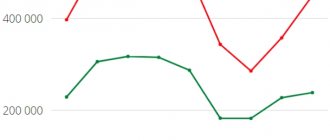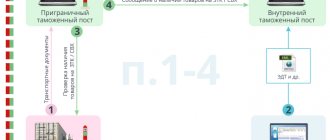Logistics hubs throughout Russia
NLT will build 38 logistics hubs throughout the country with a total area of 400 thousand square meters. m. The hub system will be three-level. At the first level there will be seven hubs located in Moscow, St. Petersburg, Kazan, Rostov-on-Don, Novosibirsk and Khabarovsk.
Level 1 hubs will open at or near airports. They will be provided with a high degree of automation of processes and the ability to carry out both export-import operations for sending parcels and sending goods to customers through Russian online stores from specially designated warehouse areas.
Russian Post and VTB have created a joint venture for e-commerce
Two first-level hubs are already operational. This is a hub opened in 2021 in Kazan and a hub launched in 2013 in Vnukovo near Moscow.
The second level will consist of 10 centers, which will be located in cities with a population of more than 1 million people and will have automated parcel sorting and warehouse areas for storing and processing goods.
At the third level, 21 centers will operate, providing service for the delivery of online orders in regions and cities with a population of more than 500 thousand people.
VIRTUAL CUSTOMS CUSTOMS AND LOGISTICS PORTAL
10.12.21
Experts spoke about the development of the self-storage warehouse market in Russia
Self storage warehouses (translated from English as “individual storage”), which are also called city boxes, are a market segment for leasing premises for storing household items in individual safes, containers, and cabinets.
They are leased to individuals and legal entities with monthly or annual payment, and sometimes daily. The world's first warehouse for storing personal belongings was built in the USA back in the 1850s, reports the portal Selfstoragespecialists.com. But it wasn't until the 1960s that the industry began to take off in the United States. In 1964, a self storage warehouse was built in Texas and the concept spread to the west coast of the country, then Canada adopted the experience. But then this business was a one-off business, and such projects did not always survive.
What's happening to the market now
Today, this business format is actively gaining momentum. According to a report by the Federation of European Self-Storage Associations (FEDESSA), by the end of 2021 the number of self-storage warehouses in Europe will increase to 5,173 warehouse premises with a total area of 11 million square meters. m. 78% of such firms are located in the six most developed countries of Europe. This year, the average rent for such storage in European countries is €268.74 per 1 sq. m. m per year, which is 7% more than in 2020.
For Russia, this is a fairly new segment - such a service first appeared in the country about 10-15 years ago. Director of the ATOL mobile solutions department Oleg Limansky told Izvestia that over the past two years, according to the company’s estimates, the number of Russian players in the self-storage warehouse market has doubled. Particularly noticeable growth is observed in cities with a population of over a million - Moscow, St. Petersburg, Novosibirsk, Yekaterinburg. In the regions, this format is still less common: the limiting factor is the lower level of income of citizens. But gradually the growth in demand for such services will go to the periphery, he believes.
ATOL estimates that about 70% of clients in this market are individuals. The remaining 30% are small and medium-sized businesses. There was a fairly noticeable influx of legal entities in 2020–2021, the company indicated.
Heated warehouses are becoming increasingly popular. The difference in price between heated and unheated premises can reach 70%, but customers more often choose warm warehouses even for storing property that is not particularly demanding in terms of temperature conditions, the company indicated.
According to Nadezhda Korkki, managing partner, if a year ago projects with storage rooms were provided in 42.1% of residential complexes sold on the primary market of Moscow, taking into account the TiNAO, now - in 43.4%.
“Their demand is explained by a decrease in the total area of apartments and a number of developers abandoning balconies, so buyers require alternative storage places. At the same time, large storage centers, city boxes, are often located at a considerable distance from residential areas in former industrial zones, which complicates logistics,” Korkka said.
Alena Volobueva, head of the research department of the real estate company Maris in association with CBRE, noted that, for example, in St. Petersburg the first self-storage warehouse was opened in 2011. In 2020–2021, a “stable growth trend” formed in the market, which should continue in the medium term, she believes.
She said that at the end of this year there were 131 self-storage complexes operating on the St. Petersburg market. Since the beginning of the year, the number of such warehouses has increased by 52 compared to the results of the fourth quarter of 2020, and the total number of operators has increased to 42. Over two years, the number of facilities on the market has increased 2.5 times.
One of the segments of the individual storage market is racking storage - placement of cargo, which is designed for goods from different product groups. Alexander Arkhipov, head of the customer service department, said that this year the demand for this service has increased by 38% compared to 2021. It is mainly used by individuals when they need to transport furniture somewhere during a renovation for a period of 3–6 months, or there is a need for seasonal storage of tires and sports equipment, without periodic collection of items.
The specialist emphasized that rack storage in this case is more profitable than renting boxes, since the client pays for the “actually used cubic meter,” and can save money by first disassembling the furniture and storing it “in boards.” According to him, this type of storage is relevant when there are a lot of things and you need to store them for a long time.
Evgeny Belov, founder of the Ambar service, said in an interview with Izvestia that now in the Russian self storage market the level of demand exceeds supply. At the same time, the client becomes more selective in terms of the range of services provided. Most companies involved in city boxes cannot satisfy the full range of client needs, he emphasized. For example, a company that provides the opportunity to rent a small cell, as a rule, does not allow the client to manage its internal contents.
Due to the fact that many cannot offer their clients a turnkey service, with the growing demand for such a service, new companies are emerging that provide services not only for storing personal belongings, but also the ability to manage them, he said.
Rates
Oleg Limansky said that the rental rate for self-storage warehouses is usually calculated per cubic meter. On average in Moscow the cost of 1 cubic meter. m varies from 1500 to 2000 rubles. The final cost depends on the location of the warehouse, the presence or absence of heating and additional services (packaging, delivery, acceptance, personal account on the website or in the application, video surveillance).
According to Nadezhda Korkki, the average price for renting a storage room in TiNAO projects in October 2021 reached 350.8 thousand rubles, in new buildings in “old” Moscow - 1 million rubles. You can rent such a room for a minimum of 148.6 thousand rubles, and a maximum of 7.7 million rubles. Over the 10 months of this year, about 7.6 thousand equity participation agreements for storage facilities were concluded in the capital’s residential complexes (only transactions by individuals were taken into account, without wholesale purchases). This is 72.7% more than in the same period last year.
In St. Petersburg, rental rates in the self-storage warehouse market are quite stable, said Alena Volobueva. As of the end of 2021, rates in heated self-storage warehouses decreased by 5.2% on average compared to the end of 2020 and ranged from 800 to 2 thousand rubles per 1 sq. m. m. per month. Rent of unheated warehouse premises over the year increased by 21.5%, to 700–1400 rubles per square meter.
Impact of the pandemic
Experts interviewed by Izvestia agreed that the coronavirus pandemic has turned out to be one of the strongest drivers of the personal storage market throughout the world, including Russia.
Oleg Limansky noted that if we talk about b2b clients in self-storage, the growth in demand was caused by a reduction in rented office space and the massive closure of catering outlets and beauty salons. According to him, some employers who temporarily transferred employees to remote work or a hybrid work format eventually extended it and abandoned large offices in order to reduce rental costs. The cost of storing excess furniture and office equipment in a warehouse is lower than the cost of renting empty space in business centers, so more and more companies are turning to this storage format, he explained.
“If we talk about catering and the service sector, due to periodic lockdowns and simply a drop in the flow of visitors due to the pandemic and, accordingly, a drop in revenue, many entrepreneurs temporarily curtailed their business and refused to rent premises during the closure. But selling furniture, equipment for summer verandas, equipment, consumables and then buying new ones is a huge cost for a business. Here, temporary storage warehouses also turned out to be the optimal solution and the demand for them has increased significantly,” said ATOL.
It was because of the pandemic that individuals began to use self-storage services more actively. Here, demand was influenced by the transition to remote work and, in connection with this, the optimization of the space of apartments and private houses for arranging a workplace. Also affected by the increase in unemployment and income levels due to the closure of enterprises amid the pandemic, which is why many city residents abandon expensive rental housing and move in with their parents or switch to the format of sharing apartments with friends and acquaintances, said Oleg Limansky.
On the one hand, those moving need to sell or store somewhere the furniture they bought for rented apartments. On the other hand, in apartments where more people begin to live, it is necessary to free up space. All these problems are often advantageously solved with the help of city boxes.
At the same time, according to Alexander Arkhipov, due to the pandemic, the supply on the market for individual storage of things has “increased greatly,” but rack storage has become a rarer occurrence.
Other growth drivers
According to Alena Volobueva, there are two factors influencing the formation of stable demand from individuals in the market. Firstly, over the past 10 years the average area of purchased housing has “significantly decreased”. Secondly, the supply of individual garages in which things could be stored is decreasing.
The market for individual parking spaces in indoor parking lots has not been able to fully fill this niche, the expert complained. The number of residential complexes that provide self-storage facilities remains small on the market. Given the rapid rise in construction costs, it is unlikely that this figure will increase in the foreseeable future, predicted the head of the Maris research department.
Oleg Limansky believes that outside of a pandemic, the increase in demand for such services is most stimulated by urbanization. In addition, economic growth in general has a positive effect on the city box market: people are purchasing more and more things that need to be stored. In Russia, the housing market has been actively increasing in recent years, which is again associated with a large number of repairs and relocations. This means that the demand for temporary storage of things is growing, he said.
Further development of the market
Global trends such as automation, digitalization, and customer focus are what will allow city boxes to remain on the market and be competitive operators in the coming years, says Oleg Limansky. He called for taking into account the fact that the amount of available space in city centers is limited and it will no longer be possible to compete due to an advantageous geographical location.
According to an ATOL specialist, older generations are accustomed to the garage storage format and are less inclined to mobility. The main audience of self storage is millennials, and it is their interests and habits that operators of such services should focus on. In turn, this audience is more willing to choose suppliers that use mobile applications and responsive websites, online booking, online payment and other modern technologies that have emerged, including in response to the pandemic, he added.
The expert also noted the importance for clients of the speed and reliability of warehouse operations when receiving and issuing things, and here the winner is the one who relies on automation: fast packaging and printing of stickers with barcodes or QR codes for each item that is sent for storage, use mobile devices in the warehouse during acceptance and delivery of goods. Data from such devices must be immediately sent in the correct format to the company’s accounting system and displayed on the website or application, he said.
As a result, city box providers will transform from ordinary warehouses into full-fledged digital platforms. It is data collection terminals, according to ATOL calculations, that make up 90% of all automation of this business, so this is a very promising market, the company emphasized.
If we talk about customer focus, those operators who offer convenient and fast delivery, more options for choosing delivery time, packaging, displaying a “product matrix” in the user’s personal account, and access to CCTV cameras through the application will be in demand, the company concluded.
In September, Knight Frank said that the volume of investments in commercial real estate in Russia in the nine months of 2021 increased, according to preliminary data, by 32% compared to the same period in 2020, to 229 billion rubles. The current result is 29% higher than the first three quarters of 2019.
News
How Post's profitability from the parcel business is growing
General Director of Russian Post Nikolai Podguzov noted that in 2021 the company processed 365 million postal items with merchandise attachments. This is 23% more than in 2016. This year an increase of another 25% is expected.
In general, over five years, due to e-commerce, the profitability of Post's parcel business will double - from the current 61 billion rubles. up to 122 billion rubles. in 2023. To maintain Pochta’s market position, it is necessary to create a digital logistics ecosystem, including sorting centers, warehouses for order processing and modern information solutions, Podguzov sums up.
Trends that will change transport logistics in 2021
Unmanned transport
Driverless trucks open up new levels of safety, efficiency and quality. They will appear on UK motorways later this year: up to three self-propelled trucks will travel in a convoy, with acceleration and braking controlled by the lead vehicle.
Russia is not yet ready to introduce unmanned vehicles - yes, we have bad roads and 4G. But the problem is being solved: in August 2021, Prime Minister Dmitry Medvedev instructed Deputy Prime Minister Arkady Dvorkovich to develop and implement a set of measures to create infrastructure for the movement of unmanned vehicles.
Using big data
Databases are an extremely valuable resource for every company. Competent and effective processes for collecting, storing, processing and interpreting big data allow you to personalize the service for each client and solve optimization problems.
Time means a lot to clients—you know that. All logistics companies try to deliver faster. Big data analysis helps with this: by studying the number of orders and goods, the situation on the road, the state of transport and other parameters, you tell the client an almost exact delivery time, and the client is satisfied. Profit!
But what about goods that require special storage conditions? Most companies invest a lot of money to deliver such goods, but you can spend much less by using Internet of Things technology. How is it used? Sensors scan temperature conditions, inventory levels, etc., then the data is analyzed offline - this is how information is generated about the safest and most economical methods of transporting and placing goods.
Augmented Reality
The boundaries between the digital and physical worlds are blurring: augmented reality (AR), a perceived reality created using computer-augmented virtual reality elements, will provide new perspectives in logistics planning and transportation execution.
Imagine that the location of cargo in the back of a truck could be visualized using a device with a built-in camera. How it works? The device has a program into which calculations of the optimal placement of the load are loaded - it builds a 3D model. You point the camera at the desired vehicle: the 3D model is combined with reality, that is, a truck with already placed cargo will be displayed on the device’s display. At the same time, the “picture” contains all the information about the objects: cargo, containers, packaging, etc.
The cargo will be placed optimally - this is the benefit of using AR in logistics. In addition, augmented reality will reduce loading and unloading time and minimize the number of errors due to the human factor.
And among Russian drivers, navigators with an information projector that is displayed on the windshield are gaining popularity. This is more than just a navigator: it allows the driver not only to track the route, but also to control the condition of the car. Everything is in one place - no need to switch your attention between multiple sources of information. This significantly improves traffic safety.
Efficient use of energy
There is a high probability that in the future the whole world will switch to renewable energy sources and will drive electric cars, because there are many advantages to this: savings on fuel, minimal pollution, no taxes for owners and parking fees, almost silent engine.
A start has already been made - more and more electric vehicles are appearing on the roads. In Russia, as of July 1, 2021, there were already 1.1 thousand of them. In addition, there are automakers (which ones are still unknown) who plan to launch serial production of electric vehicles in 2021, and the state is already creating infrastructure for them.
Moreover, the first Tesla Semi Track electric truck will appear in 2021 - its prototype was presented in California by Tesla Motors in November 2021. This vehicle is an environmentally friendly alternative to traditional diesel vehicles. The truck will be able to accelerate to 96 km/h in the first 5 seconds of movement without cargo, and with it - in 20 (with a maximum load of 36 tons).
Blockchain
The expansion of international trade and logistics is leading to the development of more efficient methods of service delivery.
Blockchain technology is an excellent solution to provide a higher level of security. It's the perfect tool to improve the way you manage your supply chain today, with a tamper-proof architecture: better security through advanced encryption, smart contracts and reduced intermediaries.
Blockchain will help fight corruption, extortion, theft and premium fees for cargo tracking. This technology is the future, that's for sure.
Without investment in logistics, Post will lose the market
President of the National Association of Electronic Commerce Participants Alexander Ivanov doubts that NLTs will be able to quickly achieve profitability. But Pochta has no other choice, since without the development of logistics, the company risks losing the market, Ivanov believes.
Cloud storage received three-level protection against ransomware
Clouds
The main competitors of Pochta in the field of servicing e-commerce enterprises are various Russian delivery services: DPD, PickPoint, BoxBerry, Pony Express, etc. Now, according to Alexander Ivanov, they control 5% of the Russian cross-border trade market and about 50-60% of the domestic Russian market Internet trading market.
It should be noted that VTB and Pochta already have experience in joint cooperation. In 2015, the parties agreed to create the Postal Bank, which operates through Post offices.
How will increased logistics prices affect the cost of goods?
But sellers will begin to factor the already increased delivery costs into final prices for consumers. As a result, goods that are most dependent on delivery costs may rise in price by an average of 3 to 10%.
At the end of 2021, tariffs for transportation by various modes of transport increased on average from 20 to 50%, but in certain directions the increase was more noticeable. If there had not been such a serious increase in transportation tariffs, suppliers could have waited for some time without raising prices in hopes of lowering them, notes Irina Zasedatel, a member of the presidium of the Association of Exporters and Importers. “But when the price increase has become multiple, goods with a high share of logistics costs will certainly win back the cost of logistics and become more expensive,” she says. So far, there is no reduction in tariffs for January, because there is not enough transportation capacity, the expert notes.
Supply prices are regulated by contracts that take into account the volume of cargo and various preferences. Long-term contracts may indicate a minimum rate, but amendments to the contract will change the rates.
Next year, transportation rates will be fixed at the achieved level, and there may even be a slight decrease of 5 - 7.5% by June-August in the multimodal segment, says Alexander Vidineev, Deputy General Director for Key Clients at Stalogistic. But this will happen if additional negative factors do not appear. For example, in the spring of this year, prices for container shipping began to rise, including after the incident in the Suez Canal, where the Ever Given cargo ship got stuck.
The fastest prices for stationery, hygiene products, and building materials—sand, crushed stone—may rise in price.
Leading logistics specialist on intermodal transport Vladimir Frentiy agrees with this assessment. According to him, after the pre-holiday rush, tariffs may decrease in the spring and summer. After the New Year, first of all, container shipping rates should decrease; congestion in world ports is already decreasing, notes Denis Gural, director of the operations department of the AsstrA group of companies. But other modes of transport will continue to grow. Tariffs for railway transportation for 2022 are planned to be indexed at 6.8%. Tariffs will also continue to rise in the first half of 2022 in the road transportation sector, says a representative of the logistics company.
Gebrueder Weiss in Russia is even less optimistic. A reduction in prices for international transportation in the near future is unlikely to be expected; on the contrary, their further increase by 5-20% is possible, depending on the type of transport and the effectiveness of measures to increase the capacity of the transport infrastructure, says Vladimir Serebryakov, general director of the company. Tariffs will go up again in the second half of 2021 due to the high season and an increasing number of cargoes, ACEX adds.
As a result, a new increase in tariffs may be added to the already occurring increase in delivery costs. The increase in logistics costs will have the greatest impact on inexpensive goods, the cost of which has a high share of delivery costs. For example, these are office supplies, inexpensive textiles, hygiene products or cheap building materials such as sand and crushed stone. According to representatives of transport companies, the final cost of such goods may increase by a third or half of the increased transportation tariffs, that is, from approximately 3 to 10%. Thus, only the indexation of tariffs for railway transportation at 6.8% will lead to an increase in the final cost of goods to 3%.
But the situation in cargo transportation will also affect the cost of expensive goods, such as cars, household appliances, and furniture due to increased delivery times. The costs of storing goods will be included in their final price for the consumer.
As a result of this year’s logistics crisis, there are more goods for which logistics has become noticeable in their cost, notes the Assessor.








